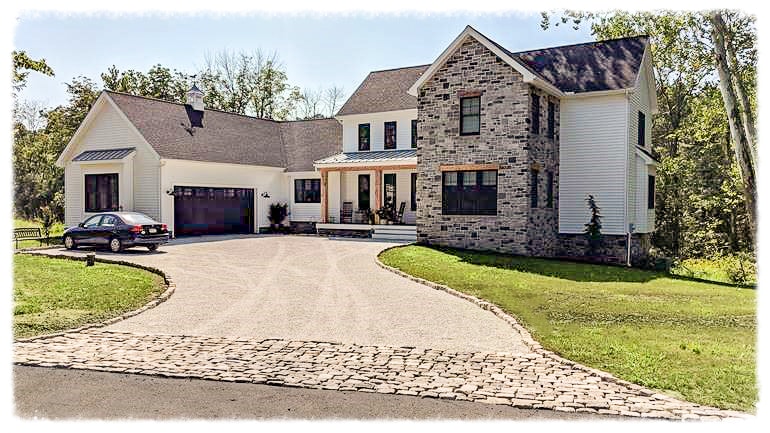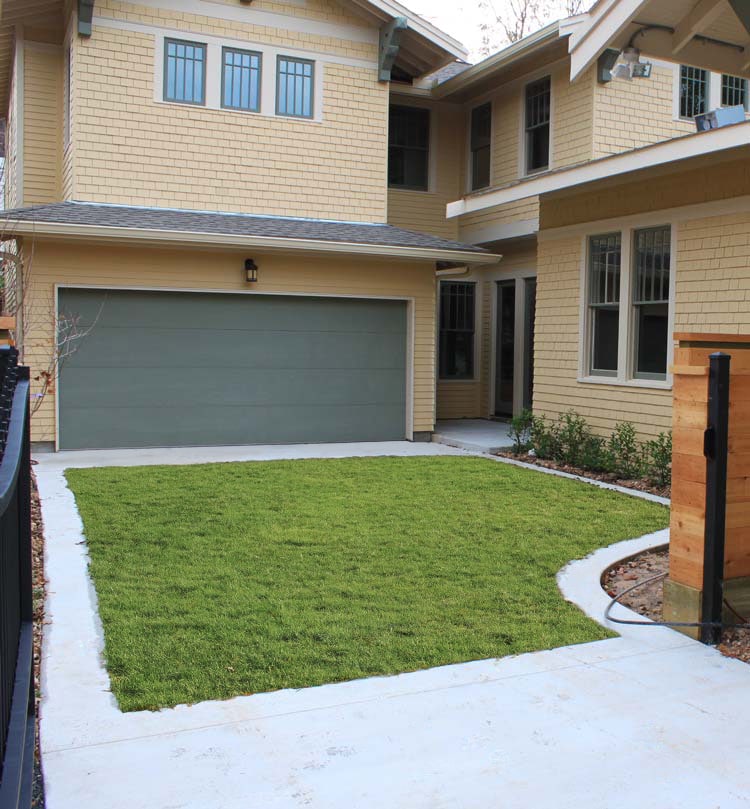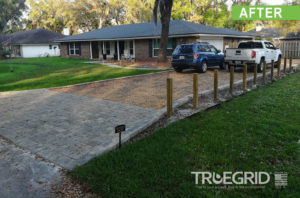Despite lasting a good amount of time – homeowner needs such as walkways, driveways, patios and roads – a large amount of energy is used to produce concrete. Apart from that, there are more cons to concrete. Rain and water runoff is incapable of soaking back into the ground whenever there is concrete. The disruption of waters natural cycle and its journey across concrete’s impervious surface causes problems. Fortunately, pervious pavers are an alternative material for a solid foundation that allows water to soak back into the ground.
Pervious is another word for permeable. You may remember the word from your science class but if not, the idea is simple. First, it needs to be addressed that permeability and porosity are often confused with one another. Although similar, they both do carry their own meaning. Porosity is the measure of how much a rock has open spaces or pockets between cracks and cavities that hold water. Permeability is a measure of how easy a fluid can move through a porous rock. They both can work alone or with each other but both are a huge part of how the environment functions and of course in both the large and microscopic processes.
Our source of drinking water comes mainly from groundwater, which is also an important sources of nutrition for plants and trees. Over the years, the amount of available groundwater has severely depleted partly due to the impermeable surfaces used in developments in and out of cities, which disallow rain and snow to recharge groundwater. Infrastructure and development such as highways, patios, walkways, roofs, driveways, even tennis courts all keep water from recharging into the ground.
Once runoff water discovers it can’t penetrate concrete and other impermeable surfaces, water diverts into storm sewage systems, into streams, and then eventually into local bodies of water. The high volume and speed of this built up waters may lead to flooding, which can cause costly damages. Toxic pollutants, such as car oil or chemicals from pesticides, are picked up by runoff water from pavement and dumped into nearby bodies of waters, such as rivers, streams and lakes where our supply of drinking water becomes slowly contaminated and harms the environment.
Before building your driveway, patio, or parking lot, address some of these issues by installing a permeable pavement. Some of these permeable pavement can even allow grass to grow and prosper within them. You can bring aesthetics to your home with many permeable options for water to properly drain on your property. Create a permeable area while also reducing heat accumulation around your building.
Concrete or Brick Pavers
Another option includes concrete or brick pavers, which are blocks that are strategically placed with a small gap in between to allow water to soak into the ground through the cracks. Although not 100 percent permeable, the allow a good amount of water to soak into the ground. These blocks can bring unique patterns and color to your pavement and as an option can allow grass to grow through the gaps for a more rustic design. Out of the two, concrete pavers are sturdier than brick but both are durable to heavy traffic. Adding concrete or brick pavers instead of any impermeable pavement, can help you and the environment in the long run. For instance, allowing some water to soak back into the ground will keep the direct and surrounding areas will need much less irrigation. That’s less work you need to do to maintain your lawn.
Plastic Grids
When searching for a cheap, easy alternative, consider using permeable plastic grids. These plastic grids are industrial strength, easy to install, and will allow for 100 percent permeability when established correctly. Before the grids are filled with gravel, the grids conveniently interlock and are placed on top of a sub-base of gravel that is 2 to 4 inches deep. This sub-base acts as a detention area that holds water temporarily to avoid flooding on the surface level. As water percolates through the top and bottom layer of crushed rock, pollutants are naturally filtered as it soaks back into the ground. Some of these plastic grids are made from 100 percent recycled post-consumer plastic, making the product environmentally-friendly starting from its manufacturing process. (For tips on installation go to our “What You Should Know About Grass Driveways” article. )
Pervious Concrete
Made from a mixture of stones and concrete, this is a porous material that is similar to the look and feel of concrete but is permeable to water. It does not require sand or gravel as a sub-base when installed and its installation is similar to concrete. This is a great option for people who want to install a material that looks like concrete but is permeable and environmentally-friendly. You do need to keep in mind of the maintenance needed to keep sediment from accumulating in the pores. Sometimes the accumulation can be too deep to be able to repair and you may have to replace the pavement if it becomes impermeable.
Once runoff water discovers it can’t penetrate concrete and other impermeable surfaces, water diverts into storm sewage systems, into streams, and then eventually into local bodies of water. The high volume and speed of this built up waters may lead to flooding, which can cause costly damages. Toxic pollutants, such as car oil or chemicals from pesticides, are picked up by runoff water from pavement and dumped into nearby bodies of waters, such as rivers, streams and lakes where our supply of drinking water becomes slowly contaminated and harms the environment.
Before building your driveway, patio, or parking lot, address some of these issues by installing a permeable pavement. Some of these permeable pavement can even allow grass to grow and prosper within them. You can bring aesthetics to your home with many permeable options for water to properly drain on your property. Create a permeable area while also reducing heat accumulation around your building.
The best permeable pavement application that would be the most beneficial to your home would be your driveway due to its exposure to heavy and foot traffic and pollutants on your property. Consider permeable materials that allow water to soak back into the ground allowing it naturally filter out pollutants, such as car oil and pesticides, to avoid contamination of nearby bodies of water that supply us with drinking water.
Create a unique outdoor space in your backyard. Adding permeable pavement to your backyard will bring some added perks that traditional patios don’t normally have.
Grass Pavement
You can pave your lawn with plastic grids to create a stabilized, grass pavement that’ll allow you to walk on even when it is muddy and rainy. The grid is laid on top of a sub-base that has a detention area capable of holding water. Not only would your lawn not be muddy and susceptible to flooding
but your dog won’t be able to dig up holes that ruin your grass.
Pool Skirt or Hot Tub Pad
If you happen to have a hot tub or a pool, you know how often the surrounding area gets wet and even slippery. Use permeable pavement to solve this issue and don’t worry about splashing on your pool shirt or hot tub pad.
Shed or Barn Foundation
Most of these applications tend to be outdoors but using permeable pavement indoors can have its own benefits. When used in a shed as the foundation, you make the ground spill-proof and keeping the inside clean of spilt liquids would be easy. For barns, livestock are naturally messy creatures and permeable pavement, such as the plastic grids, stabilizes the ground, which can help diminish the amount of mud, sludge and mess to help with cleanliness and even sanitation. Hoofed-animals benefit the most from stabilized ground since constant exposure to moisture in the ground can cause hoof disease that can be crippling.
From a grass-paved backyard to a permeable deck for your hot tub, the options are endless when you open the doors to the possibilities for your property when you introduce permeable pavement. Permeable pavement is not only a problem-solver and an alternate solution but mostly it is a better option for the environment and it goes to show that it is possible to use products that make your life not only easier but also sustainable.
Examples of Permeable Driveways






